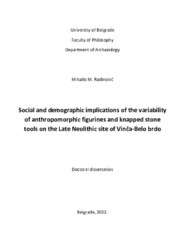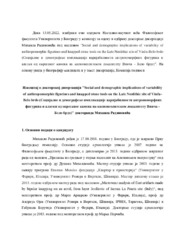Приказ основних података о дисертацији
Social and demographic implications of the variability of anthropomorphic figurines and knapped stone tools on the Late Neolithic site of Vinča-Belo brdo
Socijalne i demografske implikacije varijabilnosti antropomorfnih figurina i alatki od okresanog kamena na kasnoneolitskom lokalitetu Vinča-Belo brdo
| dc.contributor.advisor | Porčić, Marko | |
| dc.contributor.other | Marwick, Ben | |
| dc.contributor.other | Palavestra, Aleksandar | |
| dc.contributor.other | Tasić, Nenad | |
| dc.contributor.other | Vuković, Jasna | |
| dc.creator | Radinović, Mihailo | |
| dc.date.accessioned | 2022-12-08T20:36:43Z | |
| dc.date.available | 2022-12-08T20:36:43Z | |
| dc.date.issued | 2022-09-05 | |
| dc.identifier.uri | https://eteze.bg.ac.rs/application/showtheses?thesesId=8865 | |
| dc.identifier.uri | https://fedorabg.bg.ac.rs/fedora/get/o:27134/bdef:Content/download | |
| dc.identifier.uri | https://plus.cobiss.net/cobiss/sr/sr/bib/73980425 | |
| dc.identifier.uri | https://nardus.mpn.gov.rs/handle/123456789/21051 | |
| dc.description.abstract | The site of Vinĉa-Belo brdo has a rich stratigraphy with layers from different periods, but the long and continuous Late Neolithic occupation of the site and its rich material evidence have attracted particular attention of archaeologists from its discovery. The site has been studied for more than a century by many researchers who generated knowledge about different aspects of this settlement, while it also had a central place in general discussions about the Late Neolithic of the Central Balkans (~5300~4500 cal BC). During the long research history of the site, a wide variety of theoretical and methodological tools has been applied to the material culture, but the research within the cultural-historical framework has been particularly influential as it had laid some foundations of knowledge about the period, which influence the current research. However, knowledge production within the culture-historical framework relied on theoretical and methodological concepts which are now largely abandoned. Concerning the long-term socio-cultural dynamics, the subjective and unsystematic typologies, conducted on a selection of finds, were often interpreted in terms of simplistic explanations related mainly to concepts such as ethnicity, migrations, and social norms. The goal of this research is to re-evaluate certain cultural-historical interpretations of long-term cultural dynamics and offer a new perspective on this issue using novel tools and concepts. The long-term cultural dynamics were observed by a detailed analysis of anthropomorphic figurines and lithics, and interpreted in the light of cultural transmission theory. The three main research aims of this study were to – assess the character of cultural changes, explore the relationship between demography and cultural diversity, and reconstruct the models of cultural transmission. The results indicated that, contrary to frequently stated assumptions, there are no sudden cultural changes on the site, and that all cultural dynamics can be explained by the continuous, uninterrupted transmission of cultural knowledge about artifact production. Cultural changes continually appear throughout the sequence, indicating that the periodizations based on the Belo brdo sequence are arbitrary units for dividing the temporal variability of material culture. In such a scenario of continuous social reproduction, the social learning strategies were the main drivers in producing the observed stabilities and changes in the material culture, while the influence of demography on cultural dynamics is less clearly evident, although it might explain some of the observed patterns. The reconstructed models of cultural transmission (conformist, neutral, anti-conformist) indicate that the knowledge about the production of these artifact classes was partly collective, shared on the level of community, and partly individual, where a person could acquire it from any member of the community or innovate, but more research is needed to further narrow down the range of possible socio-cultural scenarios. The implications of certain conclusions go beyond this study, as they show how new tools and concepts can question some foundations of knowledge about the past and change our view about the possible scenarios of the past. | sr |
| dc.description.abstract | Lokalitet Vinĉa-Belo brdo poseduje bogatu stratigrafiju sa slojevima iz razliĉitih perioda, ali su dugotrajno i kontinuirano naseljavanje lokaliteta tokom kasnog neolita i mnoštvo materijalnih ostataka privukli posebnu paţnju arheologa još od njegovog otkrića. Lokalitet je prouĉavan više od jednog veka od strane mnogih istraţivaĉa koji su pruţili saznanja o razliĉitim aspektima ovog naselja, koje je takoĊe imalo centralno mesto u opštim raspravama o kasnom neolitu centralnog Balkana (~5300~4500 cal BC). Tokom ove duge istorije istraţivanja lokaliteta, mnoštvo teorijskih i metodoloških pristupa primenjeno je na materijalnu kulturu, ali su istraţivanja u okviru kulturno-istorijske arheologije bila naroĉito uticajna jer su postavila odreĊene temelje saznanja o ovom periodu, koja u velikoj meri utiĉu na aktuelna istraţivanja. MeĊutim, proizvodnja znanja u okviru kulturno-istorijske arheologije oslanjala se na odreĊene teorijske i metodološke koncepte koji su danas u velikoj meri napušteni. Kada je u pitanju socio-kulturna dinamika, subjektivne i nesistematske tipološke analize, sprovedene samo na pojedinim nalazima, interpretirane su u vidu pojednostavljenih objašnjenja vezanih pre svega za koncepte poput etniciteta, migracija i društvenih normi. Cilj ovog istraţivanja je preispitivanje odreĊenih kulturno-istorijskih interpretacija dugoroĉne kulturne dinamike na Belom brdu i pruţanje nove perspektive ovom pitanju upotrebom savremenih pristupa i koncepata. Kulturna dinamika posmatrana je na osnovu detaljne analize okresanih kamenih alatki i antropomorfnih figurina, a interpretirana u okviru teorije kulturne transmisije. Tri osnovna cilja ove studije bila su – prouĉavanje karaktera kulturnih promena na lokalitetu, istraţivanje odnosa izmeĊu demografije i kulturnog diverziteta, kao i rekonstruisanje modela društvenog uĉenja. Rezultati su pokazali da, surotno uvreţenom mišljenju, nema naglih kulturnih promena na lokalitetu, i da se kulturna dinamika tokom ĉitavog perioda moţe objasniti kontinuiranim, neprekinutim prenošenjem znanja o izradi artefakata. Kulturne promene se kontinuirano javljaju duţ ĉitave sekvence, ukazujući na to da su periodizacije zasnovane na sekvenci Belog brda arbitrarne jedinice za podelu vremenske varijabilnosti materijalne kulture. U ovakvom scenariju kontuinuirane društvene reprodukcije, strategije društvenog uĉenja bile su glavni ĉinioci u stvaranju uoĉenih stabilnosti i promena u materijalnoj kulturi, dok je uticaj demografskih faktora na kulturnu dinamiku manje oĉigledan, mada bi mogao objasniti odreĊene obrasce koji su uoĉeni. Rekonstruisani modeli (konformistiĉki, neutralni, anti-konfromistiĉki) društvenog uĉenja ukazuju na to da je znanje o proizvodnji ovih klasa artefakata bilo delom kolektivno, deljeno na nivou zajednice, a delom individualno, gde je individua mogla da usvoji kulturno znanje od bilo kog ĉlana zajednice ili da napravi inovaciju, ali su potrebna dalja istraţivanja da bi se dodatno suzio spektar mogućih socio-kulturnih scenarija. Implikacije odreĊenih zakljuĉaka prevazilaze okvire ove studije, jer pokazuju kako savremeni pristupi i koncepti mogu dovesti u pitanje odreĊene temelje saznanja o prošlosti i promeniti našu sliku o mogućim scenarijima prošlosti. | en |
| dc.format | application/pdf | |
| dc.language | sr | |
| dc.publisher | Универзитет у Београду, Филозофски факултет | sr |
| dc.rights | openAccess | en |
| dc.rights.uri | https://creativecommons.org/licenses/by-nc/4.0/ | |
| dc.source | Универзитет у Београду | sr |
| dc.subject | long-term cultural dynamics | sr |
| dc.subject | kulturna dinamika | en |
| dc.subject | Vinĉa-Belo brdo | en |
| dc.subject | društveno uĉenje | en |
| dc.subject | okresani kamen | en |
| dc.subject | dijahrone promene | en |
| dc.subject | antropomorfne figurine | en |
| dc.subject | karakter kulturnih promena | en |
| dc.subject | demografija | en |
| dc.subject | strategije društvenog uĉenja | en |
| dc.subject | Vinĉa-Belo brdo | sr |
| dc.subject | cultural transmission | sr |
| dc.subject | diachronic changes | sr |
| dc.subject | lithics | sr |
| dc.subject | anthropomorphic figurines | sr |
| dc.subject | character of cultural changes | sr |
| dc.subject | demography | sr |
| dc.subject | social learning strategies | sr |
| dc.title | Social and demographic implications of the variability of anthropomorphic figurines and knapped stone tools on the Late Neolithic site of Vinča-Belo brdo | sr |
| dc.title.alternative | Socijalne i demografske implikacije varijabilnosti antropomorfnih figurina i alatki od okresanog kamena na kasnoneolitskom lokalitetu Vinča-Belo brdo | en |
| dc.type | doctoralThesis | |
| dc.rights.license | BY-NC | |
| dc.identifier.fulltext | http://nardus.mpn.gov.rs/bitstream/id/148668/Disertacija_12968.pdf | |
| dc.identifier.fulltext | http://nardus.mpn.gov.rs/bitstream/id/148669/ReferatRadinovic.pdf | |
| dc.identifier.rcub | https://hdl.handle.net/21.15107/rcub_nardus_21051 |



